- Singers have recently purchased NFTs from artists such as Eminem, and producers have sold film NFTs.
- the customer receives the actual painting on canvas, which may be displayed on the wall.
- Elephant Art Online’s NFT branch is BitTrunks (EAO).
- Money will always be the driving force behind any breakthrough technology.
It’s probably not a stretch to say that the world, which has traditionally relied on paper money, is now transitioning toward digital cash. In that race, NFTs appear to be one of the most popular options.
NFT, or non-fungible token is a method of uniquely encoding a thing or a concept — physical or virtual — that resists duplication or alteration and gives proof of ownership, much like the ultimate authenticity card.
Singers have recently purchased NFTs from artists such as Eminem, and producers have sold film NFTs.
Interestingly, Dwain Schenck, co-founder of BitTrunks, told GLAMOUR BUFF that he and his colleagues launched the world’s first NFT art created by an elephant earlier this year.
“The concept that an elephant could paint was an utter surprise,” Schenck says of his initial reaction to the elephant art.
“When I watched Tunwa and Suda create this wonderful art with my own eyes, it was still too incredible to comprehend.”
The proceeds from the sale of Elephant Art NFTs, on the other hand, will be used to sustain the elephant herd at the Maetaeng Elephant Park & Clinic.
Schenck, the founder of strategic communications and consulting firm Schenck Strategies, discusses the world’s first NFT art made by elephants and all that surrounds it in the exclusive interview.
GB: A NFT art piece created by a seven-year-old elephant is unique.
Table of Contents
What was your initial impression of Elephant Art NFTs?
DS: Suda, who was already well-known for her artistic ability, wasn’t just painting landscapes.
She is capable of painting self-portraits.
And they aren’t just splashes of color splattered on canvas; they’re works of art that incorporate forests, animals, and blue skies to create something incredibly stunning.
This was by far the best thing I’d ever seen.
Let’s face it: elephants have a lot of appealing characteristics.
People are drawn to them because they are kind, intellectual, and capable of forming ties and displaying empathy.
But who knew some people could create art with their trunks?
It’s reasonable to be dubious, especially when the picture appears to have been created by a human artist.
What seals the deal is that we supply each BitTrunks NFT collector with a film chronicling the entire artistic process, from start to finish, as well as images and a certificate of authenticity.
That’s when you realize you’re not only witnessing something absolutely beautiful, but you’ve also purchased something incredibly unique, bordering on priceless.

In addition, the customer receives the actual painting on canvas, which may be displayed on the wall.
This is also historically significant since a percentage of the proceeds from the sale of each NFT goes to fund the elephant park and lifesaving medical clinic where Tunwa and Suda, along with over 80 other elephants, dwell.
Elephant Art can be purchased by visiting the official Elephant Art Online website.
GB: So, when did this whole thing start?
Tell us about the creative process and the persons involved in this remarkable project.
DS: Elephant Art Online’s NFT branch is BitTrunks (EAO). On October 18, 2021, EAO announced the launch of its NFT (non-fungible token) initial release, which would include the world’s first NFT made by an elephant.
Tunwa, a 7-year-old male elephant born and nurtured at the Maetaeng Elephant Park & Clinic in Chiang Mai, Thailand, created the first one-of-one NFT artwork to be made accessible to the public, titled the Tree of Life.
The NFT is offered on our OpenSea page, the world’s first and largest peer-to-peer NFT marketplace.
Outtakes of Tunwa’s painting, a day in his life of him interacting with other elephants in his environment, and digitally verifiable proof of authenticity of the painting are among the value-added content that comes with this particular NFT (QR Code).
Tunwa’s elephant art is inspired by the Tree of Life
Tunwa’s Tree of Life artwork
Maetaeng Elephant Park was established in 1996 to help elephants that had become free but had nowhere to go following Thailand’s logging moratorium in 1989.
After witnessing an increase in the number of elephants forced to roam city streets and work in the illegal logging trade, the park decided to create a safe and friendly work environment where visitors to the Kingdom of Thailand could see these majestic animals up close and support the park’s efforts.
Elephant caretakers began teaching a few selected elephants to paint humanely around 2000.
The plan was to gather enough funds for the park to create an elephant hospital.
This desire came realized in 2006 when the park became the first government-licensed facility in Northern Thailand to operate an elephant hospital.
GB: Can you explain to us, as the co-founder of BitTrunks, if the main motivation for launching the platform was to promote elephant-made arts?
DS: Elephant Art Online, the original supplier of authentic elephant paintings, decided to launch BitTrunks as a method to continue surprising the NFT community with frequent exclusive releases geared at investor collectors seeking long and short-term gains in the lucrative NFT market.
Our goal is to establish a one-of-a-kind offering that will serve as a profitable investment vehicle while also raising revenue to help our elephant park and elephant medical center survive and thrive.
Prior to the outbreak, Suda and Tunwa were the main attraction of the Maetaeng Elephant Park & Clinic in Chiang Mai, Thailand, painting for crowds of tourists in order to collect funds to care for and feed the parks more than 80 elephants.
Things were going well.
Then COVID-19 struck, bringing tourists to a halt – the very lifeblood and financing source for elephant care.
Our goal is to be able to rely on NFTs for funding rather than tourism.
If we can make this a viable model, we intend to extend it and assist other suffering animal parks in Thailand and beyond.
GB: That’s fantastic!
DS: Yes! We are also working on numerous new mind-blowing NFTs. We will shortly produce a lower-priced collection based on Suda’s artwork, with prices starting at 0.3 ETH.
This will enable the general NFT community to gather and exchange our NFTs.
We also intend to introduce a new collection inspired by our elephant Tunwa and his mahout (caretaker).
This means that the paintings will be created by Tunwa as well as his mahout.
GB: You previously said that the proceeds from the sale of the Elephant Art NFTs would be used to benefit the Maetaeng Elephant Park & Clinic.
Could you please elaborate on this wonderful cause?
DS: We began teaching our elephants to paint in the year 2000.
Suda is well-known for her exceptional artistic abilities.
Suda, a 15-year-old artist, has been painting for ten years.
She is in charge of raising tens of thousands of dollars for our elephant hospital.
For her enduring ability to produce stunning mountainscapes, flowering trees, and waterfalls, she has been featured on CNN, The Wall Street Journal, and Joe Rogan’s podcast.
The plan was to auction the paintings to earn funds to create an elephant clinic at the park.
In 2006, we became the first elephant park in Northern Thailand to have a government-licensed hospital on its grounds, which now treats an estimated 800 elephants in the area for free.
Elephants’ Fruit Feast
We rely on the kindness of park visitors, general donations, and the purchase of elephant paintings on our website to keep this kind of service going.
Because of COVID-19, as well as the fact that tourism and the revenues that come with it, it seemed logical to make one of our most stunning paintings into a one-of-a-kind NFT.
Nothing like it exists in the world.
It’s called the Tree of Life, and you can get it by visiting our OpenSea page.
It’s a one-of-a-kind investment opportunity that we believe will provide incomprehensible value to whoever is fortunate enough to purchase it.
The owner of this NFT will also be aware that they are contributing in ways few can comprehend by helping hundreds of elephants for years to come.
GB: Do you believe that such an outstanding campaign will raise awareness about elephant conservation and animal conservation in general?
DS: We believe BitTrunks NFTs will be a terrific investment, raising awareness about the importance of animal welfare and elephant preservation and protection.
Unfortunately, elephant numbers have declined significantly during the previous century.
While certain African elephant populations are rising, mostly in southern Africa, others are declining, most notably in central Africa and parts of East Africa.
Asian elephant populations have declined by at least 50% over the last three generations and are still declining today.
The species is categorized as endangered, with only 40,000 – 50,000 remaining in the wild.
We established the Maetaeng Elephant Park & Clinic in 1996 to provide a safe haven for the numerous elephants and their mahouts, or elephant caregivers, who had lost their jobs due to the Thai government’s ban on all forestry methods in protected forests.
With Thailand’s urbanization and commercialization in the twentieth century, the elephant habitat was devastated at an unparalleled rate, since domesticated elephants were exploited in the teak logging business by non-Thai owners until the ban in 1989.
As a result, Thai elephants are forced to rely on illegal logging, begging on the streets, or tourism to survive.
One could argue that a well-run elephant camp, such as ours, provides a nurturing environment for the elephants while also supporting the mahouts and their families.
GB: Do you have any special mentions for people who you believe are doing their utmost to support animal conservation?
DS: Joe Rogan is not linked with us in any way, but he visited our park in Chiang Mai, Thailand, a few years ago, and he has raised awareness of our elephant paintings on multiple occasions.
We are also appreciative of the countless celebrities who are raising awareness about elephant protection and conservation.
GB: Now that the initiative has been taken, we anticipate that the Elephant Art NFTs led by BitTrunks will go far. But where do you see this concept going in the coming years?
DS: The notion of creating the world’s first-ever NFT art generated by an elephant seemed like a natural extension of what has been going on at our elephant park for over a decade.
Until now, practically all NFT investors have been profit-driven.
We do see an opportunity to provide more here.
Our business concept allows altruistic investors to enter the scene and do good for themselves and, in our case, elephants.
Money will always be the driving force behind any breakthrough technology.
It remains to be seen how we all use this tool.
We believe it will evolve in the same manner as a typical art gallery, but with far greater potential and opportunity.
Suda created the Elephant Art NFT painting
According to some analysts, it is the next new fundraising frontier.
NFTs have enabled organizations, celebrities, and people to auction off their digital works, with the proceeds benefiting a charity of their choice.
In the future months and years, we will release a variety of natural and vectorized elephant art NFT collections.
We’ll also change up the topics of the artwork.
Suda and Tunwa depict more than just mountains and farmland.
They are equally skilled at painting space scenes, future landscapes, and pop art motifs.
More on that exciting front to follow.
GB: Let us concentrate a little more on NFTs and the digital market.
How might the average person benefit from such NFTs?
DS: NFTs are difficult to explain in a few phrases.
One thing is certain: it will become mainstream in the near future.
Internet 3.0 is a frequent name for NFT, Cryptocurrency, and Metaverse.
This is the future, and it means that trade and possessions will be virtual in the future, with NFTs undoubtedly playing a significant role.
NFTs will be utilized as a trade token instead of fiat money or even cryptocurrency.
Particularly in the gaming industry, where players will be able to buy game characters, skills, and items. Outside of the aforementioned applications, I believe it is too early to say how NFTs will benefit the average person.
It is a very new technology that is still developing.
GB: Also, where should we go to get these unique Elephant Art NFTs?
DS: Visit our OpenSea page to purchase a BitTrunks NFT.
Purchasing an Elephant Art NFT is an investment in some of the most unusual artworks on earth.
There’s a lot more to the art than meets the eye.
The lucky collector will usher in a brighter future for the herd – for both the older elephants and the new ones. It’s a win-win situation for everyone.
Also, read Erica Cerra: Who Is Erica Married To?
Instagram Workouts by Stephanie Sanzo
Tuna’s Tree of Life
GB: Do you have something to say to Tunwa?
Aside from that, what advice would you give to people interested in purchasing Elephant Art NFTs?
DS: It is critical that people understand that all of our elephants are treated properly and responsibly.
Every morning, the elephants at the park are escorted down to the MaeTaeng river for a daily bath, followed by a brief 30-minute stroll with their mahouts and a breakfast of fresh grass, melons, bananas, mangos, coconuts, maize stalks, and other seasonal non-citrus fruits.
Each elephant consumes up to 650 pounds of food each day, which is around 10% of its body weight.
This procedure is repeated throughout the day.
A team of vets also inspects each elephant, checking the skin, legs, feet, and eyes for signs of stress or tiredness.
Tunwa’s paintings take little more than four hours to complete, including snack breaks and time off to go about the park and eat bananas, one of his favorite delights.
Tunwa and the other painting elephants are never forced to create art, and if they lose interest, they can return later to start over or simply take the day off.




